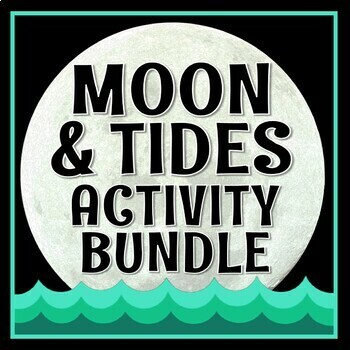Moon Phases and Ocean Tides Activity BUNDLE NGSS MS-ESS1-1
- Zip

What educators are saying
Products in this Bundle (3)
Bonus
Also included in
- Never search for "something to do tomorrow" ever again! This bundle contains PRINT AND GO lessons, NO PREP activities, LOW PREP labs, and ENGAGING articles to supplement and thoroughly enhance an Earth and space science course. Every included resource is easy to implement, standards-based, and high-Price $399.99Original Price $639.06Save $239.07
Description
SAVE 20% plus 3 FREE BONUSES! These resources are designed to supplement and add engagement to an existing moon and tides unit. Supports NGSS standards MS-ESS1-1 and MS-ESS1-2.
BUNDLE INCLUDES:
- Moon Phase Sorting Activity (FREE BONUS)
- Graphing Moon Phases
- Eclipse Starter Activity (FREE BONUS)
- Graphing Tides Activity
- Relationship Between Tides and Moon Phases Calendar Activity
- Moon Phases & Tides Manipulative Activity (FREE BONUS)
INDIVIDUAL RESOURCE DESCRIPTIONS:
Moon Phase Sorting Activity: FREE BONUS! This activity has students cut out the descriptor words (waxing, waning, gibbous, etc.), definitions, and pictures of moon phases and then decide which cutouts best relate to each other. They paste the cutouts into a 3-column chart (that they create in their notebook) under the appropriate heading of "Word", "Picture" and "Definition".
Graphing Moon Phases: In this activity, students will:
- READ brief background information on moon phases
- GRAPH the percentage of the moon that is illuminated by date
- ANSWER follow-up questions (from the graph) that relate to moon phases
Eclipse Starter Activity: FREE BONUS! As you begin teaching eclipses, try focusing on the word "eclipse" first. Students use the word in contexts OTHER than astronomy to get a feel for what the word means. Then, they apply their understanding of the word to the terms lunar eclipse and solar eclipse.
Graphing Tides Activity: Lesson Outline:
- PRACTICE using a tide chart. This familiarizes kids with reading and working with a tide chart.
- GRAPH the tide chart data for one month. We find it helpful to make groups of three, so each student only graphs one-third of the data. Students combine their graphs to make one long tide graph.
- WORK UP the graph by adding neap and spring tide labels and moon phases.
- ANSWER follow-up analysis questions.
Relationship Between Tides and Moon Phases Calendar Activity: In this activity, students will:
- READ brief background information
- ADD TIDE AND MOON PHASE DATA to monthly calendars
- ANALYZE the information to see the relationship between moon phases and extreme tides
- ANSWER follow-up questions including a Claims/Evidence/Reasoning question
Moon Phases & Tides Manipulative Activity: FREE BONUS! Students cut out pictures of the sun, Earth, and moon. On their desk, they manipulate the positions of the 3 pictures in relation to each other according to 10 different cards that say things like "spring tide", "full moon", and "solar eclipse". Students love this activity!
Teacher Notes:
- Answer keys included.
- Please note: these PDF resources are not editable.
- Also check out our best-selling MOON & TIDES TEST.
- Find lots more related resources in the MOON & TIDES Section of Our Store!
⭐⭐⭐ Click here to get 5 FREE EARTH & SPACE SCIENCE lessons! ⭐⭐⭐






